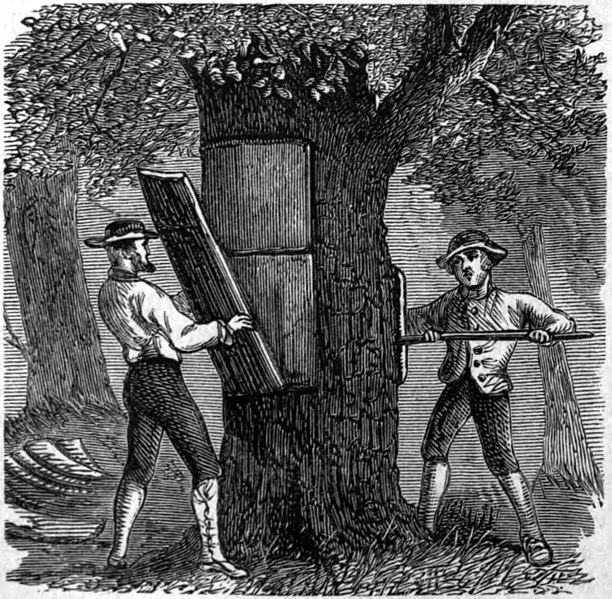| Home |
| The Magnificent Cork Oak Tree |
Previous: The Cork-Cutter’s Trade
An article published in The American Cyclopædia, 1879, explained:
Cork – the soft elastic bark of a species of oak (quercus suber) which grows abundantly in Spain, Portugal, Italy, Algeria, and the south of France.
Commerce is indebted to Portugal for its largest supply.
When the tree is 15 years old the barking is commenced, and may be repeated every eight or ten years afterward, the cork increasing in quantity though not in quality at each operation. Trees thus barked will, it is said, live 150 years. The cork is removed from the trees in July and August. (1)
| Two workers cutting bark from a cork oak |
 |
|
Antique engraving illustration from The American
Cyclopædia, Vol. 5, 1879, p. 356 (Wikipedia  ) . ) .
|
A cork oak tree in the village of Águas de Moura in Setúbal, Portugal, known as the ‘Whistler’ tree due to the large number of songbirds it attracts, was named the European Tree of the Year in 2018.
| The ‘Whistler’ cork oak, Portugal |
 |
photograph:
the
drinks business  , 11 September 2019. , 11 September 2019.
|
The Whistler tree has been harvested regularly since 1820. The 1991 harvest was the largest on record: in excess of 2,600 pounds of bark was pulled from the Whistler tree, enough material to supply over 100,000 individual corks. By comparison, when a typical cork tree is harvested it will yield around 100 pounds of bark, providing corks for about 4,000 bottles. After the famous 1991 harvest, the next stripping of cork bark from the Whistler tree, in the year 2000, was more modest in quantity (2).
The Cork Tree in England
Henry Compton, Bishop of London from 1675 until his death in 1713, was a keen botanist who took a great interest in introducing rare and exotic plants and trees to the gardens of Fulham Palace, the home of the Bishops of London. Bishop Compton is credited with planting the cork oak (quercus suber) that was 40 feet in height when visited in 1766 by Dr John Hope, King’s Botanist for Scotland and Professor of Botany at Edinburgh (3).
|
Cork tree, at the Bishop’s Palace, Fulham [west London],
print by the artist Henry William Burgess, dated 1827. |
 |
from the
Digital
Collection, The New York Public Library  . .
|
A London historian writing in 1878 described that the gardens of Fulham Palace featured a ‘great cork-tree, now much decayed, but at one time the largest in England’ (4).
In 2019 a cork oak tree near Chingford in north east London was shortlisted for England’s Tree of the Year by the Woodland Trust. It had an interesting link to Britain’s industrial past as the ‘last surviving remnant of a plantation of cork oaks planted by the Cork Manufacturing Company over a century ago’ (5). In August 1983 the Greater London Industrial Archaeology Society reported:
The last cork mill in Britain will be closing very shortly. The Cork Manufacturing Company’s factory at Hall Lane, Chingford, is due to cease production before the end of September, following which processed cork will be imported direct from Portugal for final manufacture at the firm’s remaining factory at Slough, The factory was set up in 1922 to make cricket and hockey balls and later expanded its product range to include bath mats, gaskets and insulation fittings (6).
Notes
(1)
The American Cyclopædia, Vol. 5, 1879
(Wikisource  ).
).
(2)
‘The World’s Oldest, Largest Cork Tree – The Whistler Tree’,
VinePair
 , published online 3 April 2014.
, published online 3 April 2014.
(3) Sandra Morris, ‘Legacy of a Bishop: The Trees and Shrubs of Fulham Palace Gardens Introduced 1675–1713’, Garden History, Vol. 19, 1991, p. 51.
(4)
Edward Walford, ‘Fulham’, in Old and New London, Volume 6,
London, 1878,
pp. 504–521
(British
History Online  ).
).
(5)
The
Drinks Business  , 11 September 2019.
, 11 September 2019.
(6)
Notes and News  ,
Greater London Industrial Archaeology Society (GLIAS),
,
Greater London Industrial Archaeology Society (GLIAS),
August 1983.
prepared by WhistlerHistory 2024.